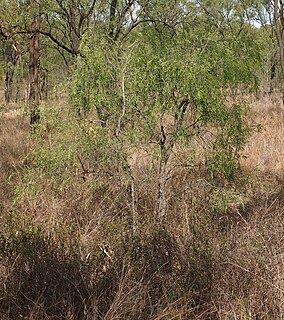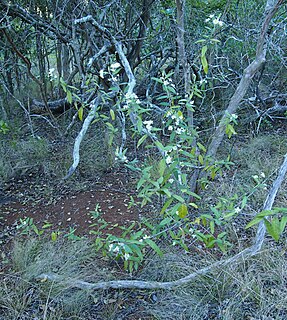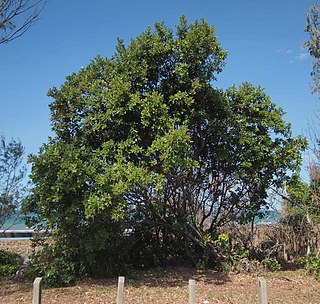Romnalda is a genus of monocotyledonous plants in the family Asparagaceae, subfamily Lomandroideae. As of December 2013 four formally named species are known and accepted by botanical science.

Storckiella is a genus of four recognised species of trees, of the plant family Fabaceae. It belongs to the subfamily Dialioideae. They grow naturally in New Caledonia, Fiji and Australia.

Diospyros pentamera is a common rainforest tree in the Ebony or Persimmon family (Ebenaceae) growing from near Batemans Bay in New South Wales to the Atherton Tableland in tropical Queensland, Australia. It is commonly known as the myrtle ebony, black myrtle, grey plum or grey persimmon.

Jagera pseudorhus, commonly named foambark, is a species of rainforest trees, in the northern half of eastern Australia and in New Guinea, constituting part of the flowering plant family Sapindaceae. Named for the saponin foam that forms on the bark after heavy rain.

Cryptocarya triplinervis is a rainforest tree growing in eastern Australia. Common names include the three veined laurel, three veined cryptocarya and the brown laurel.
Crispiloba is a monotypic genus of flowering plants containing the single species Crispiloba disperma, native to Queensland in Australia. Crispiloba disperma is a shrub species that grows to 4 metres tall. It produces fragrant white flowers followed by purplish ovoid fruits. It occurs in rainforest in North-east Queensland at altitudes ranging from 100 to 1250 metres. The species was first formally described in 1917, based on plant material collected from Mount Bellenden Ker. It was originally given the name Randia disperma and subsequently transferred to the genus Crispiloba in 1984.

Hedraianthera is a genus of a sole recognised species of shrubs or small trees endemic to Australia from the family Celastraceae.

Alphitonia petriei, known as the white ash, is a rainforest tree in the family Rhamnaceae. It grows in eastern and northern Australia. Other common names include red ash, white-leaf, pink almond and pink ash. It was originally collected from the Johnston River near Kuranda, and named in 1925 by K.W. Braid. The authors gave it the species name petriei after W.R. Petrie, who alerted them to its distinctness.

Pittosporum spinescens is a shrub native to woodlands and dry rainforest of Northern and Eastern Australia and New Guinea. Growing to 7m tall with small leaves clustered on short branches that often terminate in a sharp point. The plant produced edible fruits, 2–3 cm in diameter. It is commonly known as wallaby apple, orange thorn or thorn orange. P. spinescens is very similar in appearance to the closely related Pittosporum multiflorum, but is readily distinguished by its entire leaf margins, in contrast to the toothed leaf margins of the latter.

Dysoxylum pettigrewianum, commonly known as the spurwood, is a species of large tropical rainforest tree in the family Meliaceae. Found in Queensland, New Guinea, Solomon Islands and Malesia. In Queensland it is found in the wet tropics from Rossville near Cooktown in the north, southwards to Tully.

Croton phebalioides, is a shrub endemic to northern Australia, from Central New South Wales to Cape York Peninsula.

Denhamia oleaster is a shrub or small tree within the family Celastraceae, endemic to Queensland. The species inhabits a variety of environments, from monsoon forest to semi-arid savanna and occurs on a broad range of soil types. In more humid locales the species can grow to 6 metres in height, although it may not reach more than 1 metre in less favourable environments.

Maytenus cunninghamii is a species of shrub endemic to Australia. The natural range extends from The Kimberley and throughout The Northern Territory and Queensland. The plant grows to 6 metres in height, though it commonly flowers as a much smaller shrub. It is most commonly found in savanna and open forests, though it occasionally extends into monsoon forest.

Olearia canescens is a shrub belonging to the family Asteraceae. Commonly known as Grey Olearia, Grey Daisy Bush or New England Daisy Bush, the species is endemic to Eastern Australia, growing in monsoon forests and drier rainforest types from North Queensland to northern New South Wales. O. canescens can grow as a woody shrub up to 6 metres in height, an unusual habit for a member of the daisy family. However it more commonly exists as a low shrub of 2 – 4 metres with only a slightly woody form.

Ehretia saligna, commonly known as peach bush, native willow and peachwood is a species of shrubs or small trees, endemic to Northern Australia. The natural range extends from the Gascoyne, across the Northern Territory throughout northern Queensland and coastal; regions of Southern Queensland and New South Wales.
Hollandaea is a genus of four species known to science, of Australian rainforest trees, constituting part of the plant family Proteaceae.
Terminalia microcarpa is a tree species in the family Combretaceae. It occurs in Indonesia, Malaysia, the Philippines, Papua New Guinea and Australia.

Petraeovitex is a genus of eight climbing shrubs species known to science, of the mint family Lamiaceae . Collectively, they grow naturally in Borneo, Peninsular Malaysia, Sumatra, the Philippines, the Moluccas, New Guinea, Bismarck Archipelago, the Solomon Islands and Cape York Peninsula, Australia.
Cnesmocarpon is a genus of 4 species of rainforest trees known to science, constituting part of the plant family Sapindaceae.

Alectryon connatus, sometimes named hairy alectryon, is a species of small trees, constituting part of the plant family Sapindaceae.















